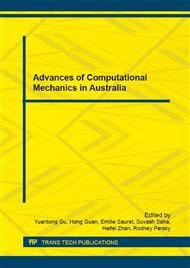p.476
p.482
p.488
p.494
p.500
p.506
p.512
p.518
p.524
Effective Thermal Conductivity of Submicron Powders: A Numerical Study
Abstract:
Effective thermal conductivity is an important property of granular materials in engineering applications and industrial processes, including the blending and mixing of powders, sintering of ceramics and refractory metals, and electrochemical interactions in fuel cells and Li-ion batteries. The thermo-mechanical properties of granular materials with macroscopic particle sizes (above 1 mm) have been investigated experimentally and theoretically, but knowledge remains limited for materials consisting of micro/nanosized grains. In this work we study the effective thermal conductivity of micro/nanopowders under varying conditions of mechanical stress and gas pressure via the discrete thermal resistance method. In this proposed method, a unit cell of contact structure is regarded as one thermal resistor. Thermal transport between two contacting particles and through the gas phase (including conduction in the gas phase and heat transfer of solid-gas interfaces) are the main mechanisms. Due to the small size of particles, the gas phase is limited to a small volume and a simplified gas heat transfer model is applied considering the Knudsen number. During loading, changes in the gas volume and the contact area between particles are simulated by the finite element method. The thermal resistance of one contact unit is calculated through the combination of the heat transfer mechanisms. A simplified relationship between effective thermal conductivity and loading pressure can be obtained by integrating the contact units of the compacted powders.
Info:
Periodical:
Pages:
500-505
Citation:
Online since:
July 2016
Authors:
Price:
Сopyright:
© 2016 Trans Tech Publications Ltd. All Rights Reserved
Share:
Citation:


